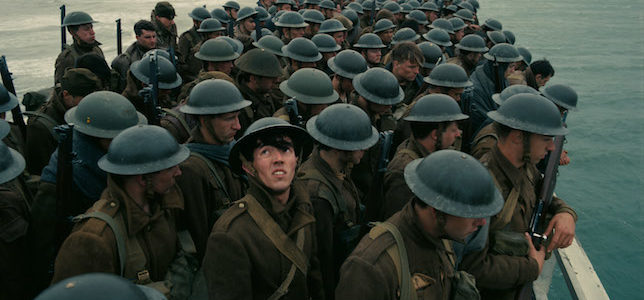
ReelBob: ‘Dunkirk’ ★★★★
By Bob Bloom
The evacuation of more than 338,000 mostly British forces evacuated from Dunkirk between May 26 and June 4, 1940, was a defeat for the Allies, but came to be seen as a victory of morale for the forces battling Nazi Germany.
Writer-director Christopher Nolan’s “Dunkirk” looks at this miraculous story of heroism and survival in a most unique way.
Nolan intertwines his story in three parts — The Mole — one week — the mole being the protective harbor where soldiers waited for the ships that would carry them home; The Sea — one day — which followed the flotilla of merchant marine ships, private fishing boats and pleasure crafts that crossed the English Channel at great risk to help in the operation; and The Air — one hour — that covered the protection given the vessels by a pair of Royal Air Force Spitfires.
Nolan’s film is an ensemble piece that continually intercuts between men on the beaches awaiting rescue, civilians on tiny boats braving the Channel and the pilots above.
Time is a toy in Nolan’s hands. As in his sci-fi thriller “Inception,” he bends it and shapes it to meet his dramatic needs, continually building tension and suspense as “Dunkirk’s” three storylines begin to merge and march ever forward.
The actors are mere chess pieces on the director’s cinematic board, as Nolan moves from shore to water to banking, soaring and diving in the air, masterfully pulling his performers’ strings.
It is done is such a dynamic fashion that despite knowing very little about any of the players involved, you become emotionally  connected to them — mourning those who die, grateful for the ones that survive.
connected to them — mourning those who die, grateful for the ones that survive.
“Dunkirk” is not your typical World War II movie about stiff-upper-lip Brits facing near-certain disaster with fortitude and resolve.
On the contrary, the movie looks at young men scrambling to endure any way they can — some of which others would consider as betrayal or cowardly.
But, heroes emerge as well: an old man, played by Mark Rylance, and two teenage boys unhesitatingly set out on the rescue mission, and two pilots, low on fuel, continue to battle German planes to save lives.
What Nolan has superbly done is immersed you directly into the fray. You bury yourself in the sand when German planes drop bombs on the helpless troops, and you gasp for breath when ships are torpedoed or bombed from the air and begin listing and sinking.
If you have any phobias about water, be aware, Nolan does not spare you the agonies of what it’s like to drown as a vessel is immersed with defenseless souls in its bowels.
The work by cinematographer Hoyte Van Hoytema and editor Lee Smith — who should earn Academy Award nominations for their work — create an immediacy, intimacy and urgency that grips you, refusing to let go.
Nolan and his team continually loop back and forth, often showing the same incidents from differing vantage points.
Also, abetting the movie’s suspense, in Hans Zimmer’s ticking score that — at times — sounds like a time bomb counting down toward detonation.
Today, what has been dubbed, “the miracle of Dunkirk,” is seen as a British victory. For had the evacuation failed and the troops on the beach been captured or decimated, England would have been vulnerable to German invasion, thus changing the tide of World War II.
Wisely, Nolan’s movie is not about the “big picture.” At about 106 minutes, it’s a fast-paced, rousing story of soldiers and civilians confronting overwhelming odds, their moral compasses, fear and the specter of death.
It is a must-see event, especially, if you have a 70mm IMAX theater within reach.
“Dunkirk” is a splendid achievement, a modern masterpiece and one of the best — if not the finest — movies of the year.
Bob Bloom is a member of the Indiana Film Journalists Association. His reviews appear at ReelBob (reelbob.com) and Rottentomatoes (www.rottentomatoes.com). He also reviews Blu-rays and DVDs. He can be reached by email at bobbloomjc@gmail.com or on Twitter @ReelBobBloom.
DUNKIRK
4 stars out of 4
(PG-13), intense images of war and violence, language
